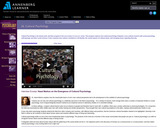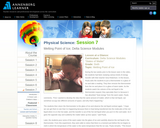
An interactive resource on annotating and close textual reading from Solomon Northup's Twelve Years a Slave.
- Subject:
- English Language Arts
- Material Type:
- Interactive
- Provider:
- Annenberg Learner
- Author:
- Annenberg Learner
- Date Added:
- 02/26/2019

An interactive resource on annotating and close textual reading from Solomon Northup's Twelve Years a Slave.

Although they are best known for their use in agriculture to increase yields and fight crop diseases, genetic modification techniques are used in many different areas of biological research, including medicine. In this case study, we'll follow the process of developing an edible vaccine for the hepatitis B virus and explore practical details of genetic engineering techniques.

Students will use area models to multiply and reduce fractions.

This lesson teaches students about direct variation by allowing them to explore a simulated oil spill using toilet paper tissues (to represent land) and drops of vegetable oil (to simulate a volume of oil).

Students explore quadratic functions by using a motion detector known as a Calculator Based Ranger (CBR) to examine the heights of the different bounces of a ball. Students will represent each bounce with a quadratic function of the form y = a (x - h)^2 + k. This lesson plan is based on the activity Tremain Nelson uses in the video for Part II of this workshop.

Students use blocks to build a design from a written description. Try various descriptions to achieve the correct design.

Students classify the different types of numbers we use, and learn how numbers and operations relate to one another. They start with counting numbers and then add integers, rationals, algebraic, and, finally, real numbers to the line.

Using an interactive that explores four ancient civilizations - The Maya, Mesopotamia, Chaco Canyon, and Mali/Songhai, students will evaluate and analyze what happens when a society collapses and how archaeologists find and interpret evidence.

In this video, students look at the process and elements of interpreting reality. Students explore the power of cognitive control, the Pygmalion effect, the development of prejudice, and how expectations affect behaviors like performance and compliance.

Students build staircases out of square blocks. They look for patterns and come up with a rule or formula to predict the number of blocks in any staircase.

This video explores how cultural psychology integrates cross-cultural research with social psychology, anthropology, and other social sciences. It also examines how cultures contribute to self identity, the central aspects of cultural values, and emerging issues regarding diversity.

Students learn about basic recursion by exploring patterns in the data they generate from two simple probability-based experiments.

Students collect data on the number of raisins in 17 boxes of raisins. They will use the data to analyze data and interprete results, answer a series of questions about variation, and construct data in plots.

Students Imagine constructing an open-topped water tank from a square metal sheet. They investigate the relationship between the maximum volume of the tank and the size of the squares cut from the corners, build models and collect data.

This program explores the evolution of cognitive psychology and how we take in information. Cognitive psychology spans a vast range of study, from the parts of the brain used in reading to the computer's impact on the study of how humans think. Cognitive Processess is the tenth program in the DISCOVERING PSYCHOLOGY series.

Video discusses the basic principles of how we learn; classical, instrumental, and operant conditioning; and the role that stimuli and consequences play in learned behavior and habits.

This video unravels the complex process of how we see. Students will learn about visual illusions and what causes them, the biology of perception, the visual pathway, and how the human brain processes information during perception. Sensation and Perception is the seventh program in the DISCOVERING PSYCHOLOGY series.

This video explores the scientific method, the distinction between fact and theory, and the different ways in which data are collected and applied, both in labs and in real-world settings.

This lesson has two parts. In part one, students use Slinkys to demonstrate S and P waves and then discuss how the motions of earthquakes might provide scientists with information about the Earth's interior. In the second part, students use toy putty to model the mantle of the Earth.

This video demonstrates the difference between heat and temperature and examines how both are defined in terms of particles. It illustrates the transfer of heat energy and uses a particle model to explain a number of everyday phenomena, including why things expand when they are heated to the role that temperature plays in changes of states of matter.